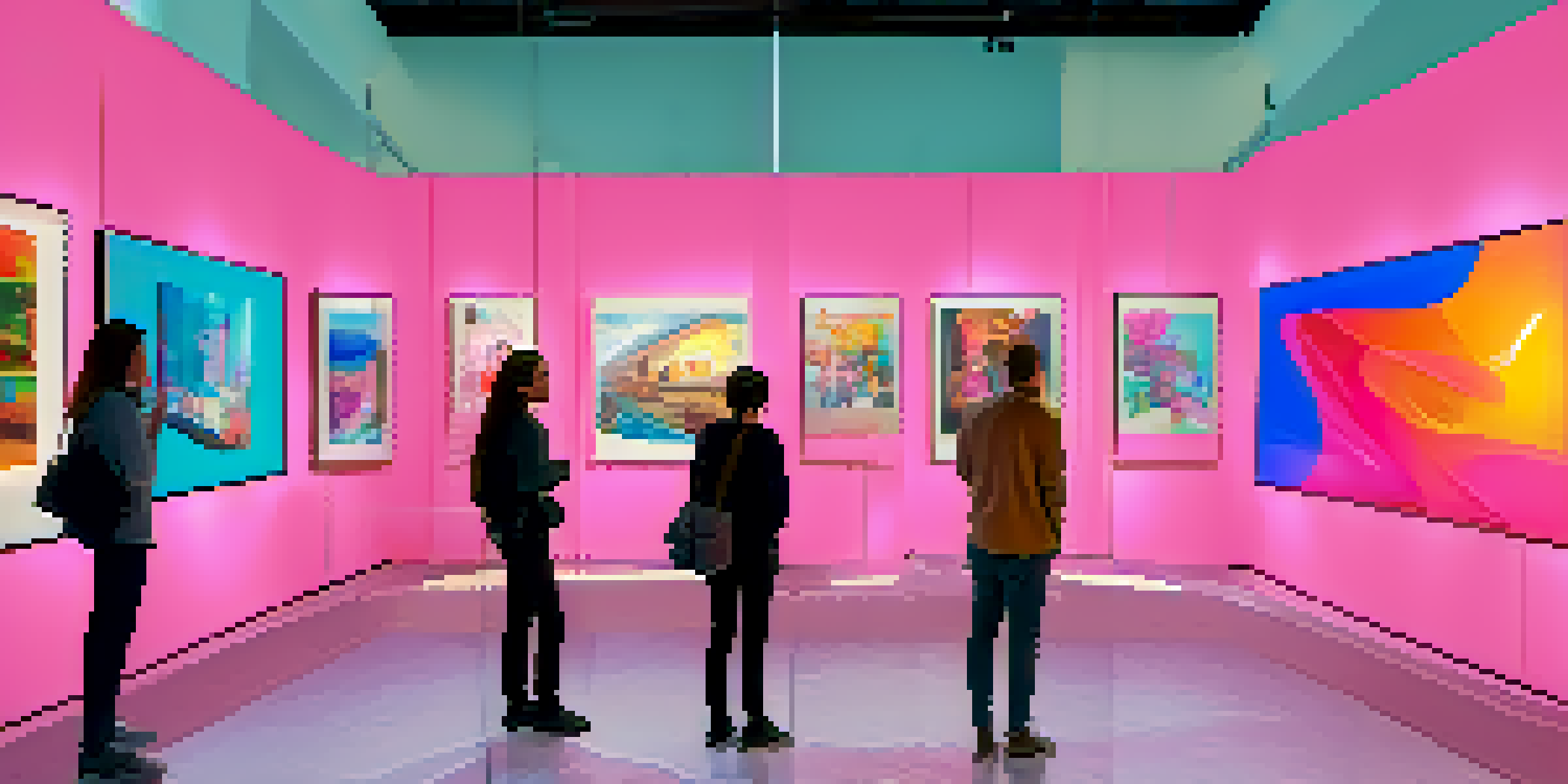NFTs on Ethereum: Redefining the Digital Art Marketplace

Introduction to NFTs and Their Rise in Popularity
Non-fungible tokens, or NFTs, have taken the digital world by storm. They represent unique digital assets that cannot be exchanged on a one-to-one basis, unlike cryptocurrencies such as Bitcoin. This uniqueness is what makes NFTs particularly appealing to artists and collectors alike.
Art is not freedom from discipline, but disciplined freedom.
The rise of NFTs can be attributed to the increased interest in digital art and the growing acceptance of blockchain technology. As more artists and creators explore new ways to monetize their work, NFTs have emerged as a revolutionary solution. This shift has led to a surge in digital art sales, with some pieces fetching millions at auction.
Ethereum, the primary blockchain for NFTs, provides a decentralized platform that supports these unique tokens. Its smart contract capabilities allow artists to create and sell their work directly, fostering a new sense of ownership and authenticity in the digital realm.
Understanding Ethereum's Role in the NFT Ecosystem
Ethereum is the backbone of the NFT marketplace, providing the infrastructure needed to create, buy, and sell these tokens. Its blockchain technology ensures that every transaction is secure, transparent, and immutable, which builds trust among users. This inherent security is crucial for artists who want to protect their intellectual property.

Smart contracts on Ethereum automate transactions, enabling creators to set specific conditions for their art sales. For example, artists can earn royalties each time their work is resold, creating ongoing revenue streams. This feature is a game changer, as it allows artists to benefit from the appreciation of their work over time.
NFTs Empower Digital Artists
NFTs provide artists with direct access to global audiences, allowing them to sell their work without intermediaries.
Additionally, Ethereum hosts a vibrant community of developers and enthusiasts who continuously innovate within the NFT space. This collaborative environment encourages the development of new tools and platforms, enhancing the overall NFT experience for both artists and collectors.
The Impact of NFTs on Digital Artists and Their Work
NFTs have provided digital artists with unprecedented opportunities to showcase their work. Artists no longer have to rely on traditional galleries or intermediaries to sell their art; they can reach a global audience directly through NFT marketplaces. This democratization of art sales is empowering creators and diversifying the art world.
The future belongs to those who believe in the beauty of their dreams.
Moreover, NFTs allow artists to express their creativity in innovative ways. The digital nature of NFTs enables the incorporation of multimedia elements, such as animations and interactivity, that traditional art cannot offer. This opens up a whole new realm of possibilities for artistic expression.
However, the NFT space is not without its challenges. Issues such as environmental concerns related to blockchain energy consumption and market volatility can create uncertainty for artists. As the industry matures, addressing these challenges will be crucial for sustaining its growth.
Exploring Popular NFT Marketplaces on Ethereum
Several marketplaces have emerged on Ethereum, each offering unique features and experiences for users. Platforms like OpenSea, Rarible, and Foundation are leading the charge, providing artists and collectors with accessible venues to trade NFTs. Each marketplace has its own vibe and community, catering to different niches within the digital art landscape.
OpenSea, for instance, is one of the largest NFT marketplaces and supports a wide array of digital assets, from art to virtual real estate. Its user-friendly interface makes it easy for newcomers to navigate the world of NFTs. On the other hand, Foundation focuses on curated drops, emphasizing quality over quantity in its selection of artworks.
Ethereum Drives NFT Marketplace
Ethereum's blockchain technology enables secure transactions and supports the creation and trading of NFTs.
These marketplaces not only facilitate transactions but also foster community engagement. Artists can connect with collectors, collaborate with other creators, and participate in events that celebrate digital art. This sense of community is vital for the growth of the NFT ecosystem.
Challenges and Criticisms of NFTs in the Art World
Despite their popularity, NFTs face several criticisms that cannot be overlooked. One major concern is the environmental impact of blockchain technology, particularly the energy-intensive processes involved in minting and trading NFTs. Many artists and collectors are advocating for more sustainable practices to mitigate this issue.
Additionally, the speculative nature of the NFT market raises questions about the long-term value of digital art. As prices for some NFTs skyrocket, there's a growing fear that the market could be a bubble waiting to burst. This uncertainty can deter potential buyers and artists from entering the space.
Furthermore, issues surrounding copyright and ownership can create confusion for both artists and collectors. As the NFT market grows, the need for clearer regulations and guidelines becomes increasingly important to protect the rights of creators and ensure fair practices.
NFTs and the Future of the Digital Art Marketplace
Looking ahead, NFTs are poised to play a significant role in the evolution of the digital art marketplace. As technology continues to advance, we can expect to see more innovative applications of NFTs that enhance the way art is created, shared, and sold. This could include features like augmented reality experiences and interactive storytelling.
Moreover, as awareness of NFTs grows, traditional institutions, such as museums and galleries, are beginning to embrace this technology. Collaborations between digital artists and established art entities could lead to exciting new opportunities and greater recognition for digital art as a legitimate form of expression.
Challenges in the NFT Space
The NFT market faces criticisms regarding environmental impact, market volatility, and the need for clearer regulations.
Ultimately, the future of NFTs will depend on how the community addresses current challenges. Balancing innovation with sustainability and ethical practices will be key to ensuring that NFTs remain a viable and respected segment of the art world.
Conclusion: Embracing the NFT Revolution
In conclusion, NFTs on Ethereum are redefining the digital art marketplace in profound ways. They offer artists new avenues for monetization, enhance creative possibilities, and foster community engagement. As technology continues to evolve, the potential for NFTs to transform the art world is immense.
While there are challenges and criticisms to navigate, the enthusiasm and innovation within the NFT space are undeniable. Artists, collectors, and enthusiasts alike are excited about the future of digital art, and the possibilities that NFTs present.

Embracing this revolution means staying informed, adapting to changes, and supporting sustainable practices. As we move forward, the journey of NFTs and digital art is one to watch closely, as it unfolds new chapters in the story of creativity.